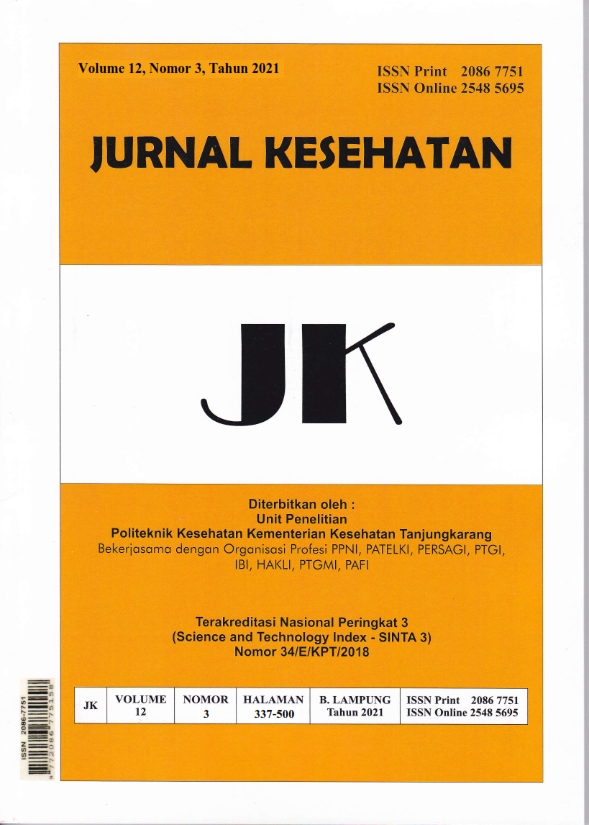Literature Review: Masalah Kesehatan Anak Jalanan
DOI:
https://doi.org/10.26630/jk.v12i3.1993Keywords:
Problem health, Risk factors, Street children.Abstract
An increase in the number of street children saved by the world due to several factors such as family problems, poverty, difficulties in the household, parents, challenges, and family assistance are also reasons why children prefer to choose the road. This literature review aims to analyze or find out about health problems in street children. After reviewing the 5 articles, it can be concluded that three problems are often faced by street children, namely physical, psychological and social health problems. The problem of street children is a shared responsibility, the need for the role of cross-sectoral cooperation, both government, community, and educational institutions to solve the problems of street children. From this research, it is concluded that three problems are often faced by street children, namely physical, psychological and social health problems. Physical problems often experienced by street children are growth and nutrition problems, physical injuries, parasites and community-acquired infectious diseases, sexual and reproductive health problems, sexual violence and abuse, drug use and abuse. Meanwhile, the psychological problems of street children include psychiatric disorders such as depression, hopelessness, and suicidal thoughts. The social health problems of street children are economic and social. Street children are also often victims of neglect, psychological, physical, sexual abuse and are susceptible to sexually transmitted infections.
Â
References
Alem, H. W., & Laha, A. (2019). Role of social intervention in addressing problems of street children: Evidences from the regional State of Oromia, Ethiopia. Indian Journal of Economics and Development, 7(5).
Arini, S., & Pudjiati, S. R. R. (2017). The Correlation between Perceived Social Support and Mental Health among Adolescent Street Children. The Third Asia Future Conference.
Astri, H. (2018). Kehidupan anak jalanan di Indonesia: Faktor penyebab, tatanan hidup dan kerentanan berperilaku menyimpang. Aspirasi: Jurnal Masalah-Masalah Sosial, 5(2), 145-155.
Attia, M. S., Tayel, K. Y., Shata, Z. N., & Othman, S. S. (2017). Psychosocial profile of institutionalised street children in Alexandria, Egypt: A comparative study with school children. Journal of Child & Adolescent Mental Health, 29(2), 103-116. https://doi.org/10.2989/17280583.2017.1339606
Ayub, T., Kumar, D., & Shora, T. N. (2016). Psychosocial, demographic, educational and health characteristics of street children–a qualitative study. International Journal of Medical Science and Public Health, 5(08), 1.
Bhusal, S. (2016). Street Children in Butwal Municipality: A Case Study. Tribhuvan University Journal, 29(1), 191-202.
Cénat, J. M., Derivois, D., Hébert, M., Amédée, L. M., & Karray, A. (2018). Multiple traumas and resilience among street children in Haiti: Psychopathology of survival. Child Abuse & Neglect, 79, 85-97. https://doi.org/10.1016/j.chiabu.2018.01.024
Cumber, S. N., & Tsoka-Gwegweni, J. M. (2015). The Health Profile of Street Children in Africa: A Literature Review. Journal of Public Health in Africa, 6(2), 566. https://doi.org/10.4081/jphia.2015.566
Deb, S., Sunny, A. M., & Majumdar, B. (2020). Street Children: The Paradox of Untapped Human Resources. In Disadvantaged Children in India (pp. 1-47). Springer, Singapore.
Diallo, O., Wang, G., & Toure, H. (2015). Livelihoods Used by Street Children for Survival in Bamako, Mali. International Journal of Psychological Studies, 8(1), p53.
Fiasorgbor, D. A., & Fiasorgbor, E. K. (2015). Street children: Our health and coping strategies when we are sick. Journal of Health, Medicine and Nursing, 15(1), 45-50.
Hanafi, B. (2017). Keterlibatan Anak dalam Ekonomi Keluarga dan Pemenuhan Hak-Hak Anak (Studi Kasus Anak Jalanan yang Bekerja di Terminal Terpadu Amplas Kelurahan Timbang Deli Kecamatan Medan Amplas). [Skripsi]. Medan: Fakultas Ilmu Sosial dan Ilmu Politik, Universitas Sumatera Utara.
Haydar, S. (2017). Literacy Drive and Rehabilitation of the street children of Kolkata: An analytical study. Lulu. com.
Mugianti, S., Winarni, S., & Pangestuti, W. D. (2018). Faktor Penyebab Remaja Menjadi Anak Jalanan. Jurnal Pendidikan Kesehatan (e-Journal), 7(1), 25-31.
Nayak, A. (2018). Health status of street children in Bhubaneswar, capital city of Odisha–A study. International Journal of Home Science, 4(2), 32-34.
Nuzula, F. (2019). Pengaruh Penyuluhan Tentang Personal Hygiene Dan Dampak Penyakit Yang Ditimbulkan Terhadap Tingkat Pengetahuan Pada Anak Jalanan (Studi pada Jaringan Kemanusiaan Jawa Timur di Malang). [Skripsi]. Malang: Universitas Muhammadiyah Malang.
Oppong Asante, K. (2016). Street Children and Adolescents in Ghana: A Qualitative Study of Trajectory and Behavioural Experiences of Homelessness. Global Social Welfare, 3(1), 33-43.
https://doi.org/10.1007/s40609-015-0039-8
Rakhmaniyah, A. (2020). Gambaran Kualitas Hidup Anak Jalanan yang Mengamen. [Skripsi]. Jakarta: Universitas Tarumanagara.
RamBihariLal Shrivastava, S. (2014). Developing a Coordinated Response to Counter the Public Health Menace of Street Children. Biology and Medicine, 06(03). https://doi.org/10.4172/0974-8369.1000e112
Ramu, K. (2018). A Descriptive Study to Assess the Selected Psychosocial Problems Among Street Children in Foster Homes at Tumkur, Karnataka, India. J Nurs Health Stud, 3(3), 10.
Suryaningsih, C., & Nur, M. F. (2020). Pengalaman Hidup Anak Jalanan Usia Remaja. Jurnal Keperawatan Silampari, 4(1), 31-39.
Tefera, B. (2015). The situation of street children in selected cities of South Sudan: Magnitude, causes, and effects. Eastern Africa Social Science Research Review, 31(1), 63-87.
Tumangger, B. K., & Riasih, T. (2020). Eksploitasi Terhadap Anak Jalanan Di Kota Bandung. Jurnal Ilmiah Perlindungan & Pemberdayaan Sosial, 2(2).
UNICEF. (2019). UNICEF’s mission statement. UNICEF’s Mission Statement. https://www.unicef.org/about/who/index_mission.html
Van Daalen, E., Hanson, K., & Nieuwenhuys, O. (2016). Children’s rights as living rights: The case of street children and a new law in Yogyakarta, Indonesia. The International Journal of Children’s Rights, 24(4), 803-825.
Wardani, I. Y. (2018). Stres dan Strategi Koping Anak Jalanan di Kota Depok. Jurnal Persatuan Perawat Nasional Indonesia (JPPNI), 2(2), 108-116.
Zaman, B. (2019). Pendidikan Akhlak pada Anak Jalanan di Surakarta. INSPIRASI: Jurnal Kajian dan Penelitian Pendidikan Islam, 2(1), 129-146.
Zulfendri, Lubis, A., Salmah, U., & Syahri, I. (2017). Health Problems of Street Children in the Medan Amplas Station. 2nd International Conference on Social and Political Development (ICOSOP 2017).
Downloads
Additional Files
Published
Issue
Section
License
Authors who publish in this journal agree to the following terms:
- Authors retain copyright and grant the journal right of first publication with the work simultaneously licensed under a Creative Commons Attribution License (CC BY-SA 4.0) that allows others to share the work with an acknowledgment of the work's authorship and initial publication in this journal.
- Authors can enter into separate, additional contractual arrangements for the non-exclusive distribution of the journal's published version of the work (e.g., post it to an institutional repository or publish it in a book), with an acknowledgment of its initial publication in this journal.
- Authors are permitted and encouraged to post their work online (e.g., in institutional repositories or on their website) prior to and during the submission process, as this can lead to productive exchanges and earlier and greater citations of published work.












